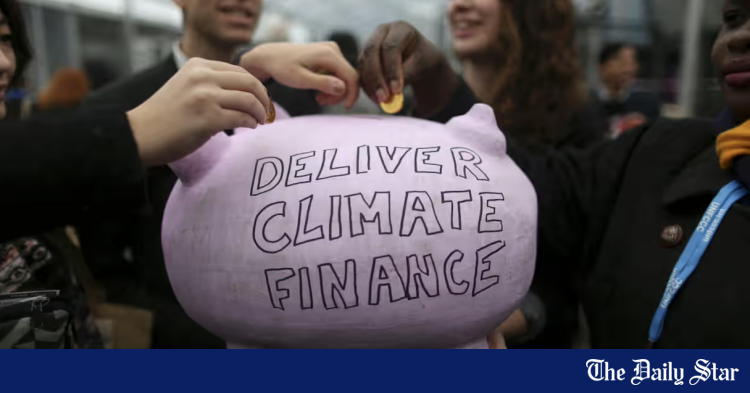Saif
Senior Member
- Joined
- Jan 24, 2024
- Messages
- 15,828
- Likes
- 7,967
- Nation

- Axis Group


Govt has issues to shore up to offset Rampal’s evil impact
THE detrimental effects that the Centre for Environmental and Geographic Information Services says the coal-based Rampal Power Plant has on the environment of the Sunderbans are...
 www.newagebd.net
www.newagebd.net
Govt has issues to shore up to offset Rampal’s evil impact
04 November, 2024, 00:00
THE detrimental effects that the Centre for Environmental and Geographic Information Services says the coal-based Rampal Power Plant has on the environment of the Sunderbans are appalling. The hazard that the Bangladesh-India joint venture plant has forced on the environment is, however, all that experts predicted well before the plant’s installation. The Centre for Environmental and Geographic Information Services, a state-owned entity, in its latest assessment says the 1.23GW plant, commissioned in October 2022, has been running without an effluent treatment, adversely affecting the River Maidara with a direct discharge of wastewater. The handling of coal unloaded from the ship being carried over a distance of 25 metres on a conveyor belt runs uncovered, which releases coal ash into the air and water, the assessment conducted in February–April says. Coal sheds, coal stack yard and ash silos are not yet finished, resulting in the pollution of water with an increased concentration of the total dissolved solids such as mercury, nitrate and phosphate. No bird’s nest was spotted in the project area during the assessment. Construction materials and wastes were still piled up in the area and there is no sewage management system. Waterkeepers Bangladesh, which works to protect water and water bodies, says that all this might be the tip of iceberg.
When green campaigners earlier held brief against the installation of the power plant within 14 kilometres of the Sunderbans, citing its likely adverse impact on the environment, the energy adviser to the now deposed prime minister Sheikh Hasina brushed aside the opposition to the plant’s installation saying that the impact that the campaigners were talking about was ‘not based on facts.’ What is disparaging about this is that the Centre for Environmental and Geographic Information Services that time certified the project as ‘not being environmentally harmful’ in its environmental impact assessment. The institution went to great lengths to oppose local and international experts. The institution has always manipulated reports seeking to please successive governments. It was also earlier predicted that the steps promised to keep the power plant as clean as possible could not be achieved as such steps would only add to the production cost. Inhabitants of the area now allege illness such as breathing problems. Although the Bangladesh-India Friendship Power Company Ltd, which owns the power plant, has rejected the assessment, experts believe that the situation on the ground is harsher than what the state entity’s report has come up with, noting that the entity has not pointed out most of the violations in its previous assessment reports. Green campaigners now want a transparent assessment of the plant on the environment.
The power plant is affecting the country economically, ecologically and socially. The country cannot even use a half of the plant’s capacity because of fuel shortage and technical glitches. The government should, therefore, conduct an unbiased assessment, shore up issues that would reduce the detrimental impact of the plant on the environment based on the assessment. It could weigh options to close down the plant in the long run.
04 November, 2024, 00:00
THE detrimental effects that the Centre for Environmental and Geographic Information Services says the coal-based Rampal Power Plant has on the environment of the Sunderbans are appalling. The hazard that the Bangladesh-India joint venture plant has forced on the environment is, however, all that experts predicted well before the plant’s installation. The Centre for Environmental and Geographic Information Services, a state-owned entity, in its latest assessment says the 1.23GW plant, commissioned in October 2022, has been running without an effluent treatment, adversely affecting the River Maidara with a direct discharge of wastewater. The handling of coal unloaded from the ship being carried over a distance of 25 metres on a conveyor belt runs uncovered, which releases coal ash into the air and water, the assessment conducted in February–April says. Coal sheds, coal stack yard and ash silos are not yet finished, resulting in the pollution of water with an increased concentration of the total dissolved solids such as mercury, nitrate and phosphate. No bird’s nest was spotted in the project area during the assessment. Construction materials and wastes were still piled up in the area and there is no sewage management system. Waterkeepers Bangladesh, which works to protect water and water bodies, says that all this might be the tip of iceberg.
When green campaigners earlier held brief against the installation of the power plant within 14 kilometres of the Sunderbans, citing its likely adverse impact on the environment, the energy adviser to the now deposed prime minister Sheikh Hasina brushed aside the opposition to the plant’s installation saying that the impact that the campaigners were talking about was ‘not based on facts.’ What is disparaging about this is that the Centre for Environmental and Geographic Information Services that time certified the project as ‘not being environmentally harmful’ in its environmental impact assessment. The institution went to great lengths to oppose local and international experts. The institution has always manipulated reports seeking to please successive governments. It was also earlier predicted that the steps promised to keep the power plant as clean as possible could not be achieved as such steps would only add to the production cost. Inhabitants of the area now allege illness such as breathing problems. Although the Bangladesh-India Friendship Power Company Ltd, which owns the power plant, has rejected the assessment, experts believe that the situation on the ground is harsher than what the state entity’s report has come up with, noting that the entity has not pointed out most of the violations in its previous assessment reports. Green campaigners now want a transparent assessment of the plant on the environment.
The power plant is affecting the country economically, ecologically and socially. The country cannot even use a half of the plant’s capacity because of fuel shortage and technical glitches. The government should, therefore, conduct an unbiased assessment, shore up issues that would reduce the detrimental impact of the plant on the environment based on the assessment. It could weigh options to close down the plant in the long run.











































